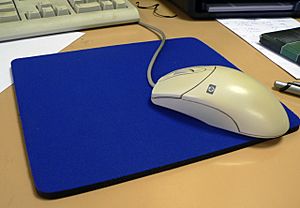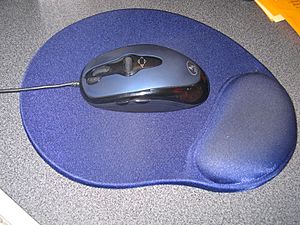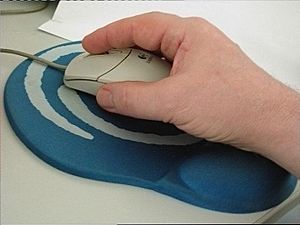Mousepad facts for kids
A mousepad is a special mat you put on your desk. It's where you place and move your computer mouse. Using a mousepad makes your mouse work much better. It helps the mouse track your movements smoothly and precisely. Some mousepads even have a soft cushion for your wrist. This makes using the mouse more comfortable.
Contents
History of Mousepads
The idea for a mousepad came about a long time ago. In 1968, a scientist named Douglas Engelbart showed off the first computer mouse. He used a special desk that had a built-in area for the mouse.
Jack Kelley, who designed that desk, is said to have created the first mousepad in 1969. By 1982, many people using early computer mice were already using "special pads." These pads helped the mouse's ball move better.
The first company to sell mousepads was Moustrak. They became popular when Apple started giving away Moustrak mousepads with the Apple logo. Moustrak even made deals with companies like Disney. However, by the late 1980s, many cheaper mousepads appeared. This made mousepads a common and inexpensive item.
The word "mouse pad" first appeared in a publication in 1983. The British term "mousemat" was first used in 1989.
Why Use a Mousepad?
Mousepads offer several great benefits for computer users.
Better Mouse Performance
One main reason to use a mousepad is for better mouse control. It helps your mouse move faster and more accurately. This is especially true for tasks like gaming or graphic design. A mousepad also prevents the mouse pointer from jumping around on your screen. This happens when dirt gets stuck under the mouse.
Protecting Your Desk
Another good reason is to protect your desk. Moving a mouse directly on a table can scratch or wear down the surface over time. A mousepad acts as a barrier, keeping your desk looking nice.
Optical Mouse Use
When optical mice first came out, they needed special mousepads. These pads had patterns that helped the mouse "see" its movement. Today, most optical mice work well on many surfaces. But many users, especially gamers, still prefer a mousepad. It gives them better comfort, speed, and accuracy.
Different Types of Mousepads
Mousepads come in many different types. They have various surfaces to work best with different mouse technologies.
Surfaces for Ball Mice
In the past, mice had a ball underneath them. For these mice, fabric-surface mousepads were very popular. They helped keep the mouse ball clean. This led to smoother tracking and better accuracy. Without a mousepad, dirt would collect on the ball. This would make the pointer move unevenly on the screen.
Surfaces for Optical Mice
Older optical mice sometimes had trouble on shiny surfaces. Glass or polished wood could make the mouse pointer jump around. Mousepads with special surfaces helped fix this problem. They made sure the mouse tracked smoothly.
Wireless Charging Mousepads
Some newer mousepads have a cool feature. They can wirelessly charge your mouse! This means you don't need to worry about changing or recharging batteries. You can just use your wireless mouse without interruption.
What Mousepads Are Made Of
Modern mousepads are usually made from rubber. They often have a fabric surface on top. However, many other materials have been used to make mousepads.
Common Materials
Some common materials include:
- Fabric
- Plastics
- Recycled rubber (like from tires)
- Neoprene (a type of synthetic rubber)
- Silicone rubber
- Leather
- Glass
- Cork
- Wood
- Aluminum
- Stone
- Stainless steel
Gaming Mousepads
High-quality mousepads for gaming are often made from special materials. These include plastic, glass, aluminum, or advanced fibers. These materials are chosen for their smooth glide and durability.
Images for kids
See also
 In Spanish: Alfombrilla de ratón para niños
In Spanish: Alfombrilla de ratón para niños






